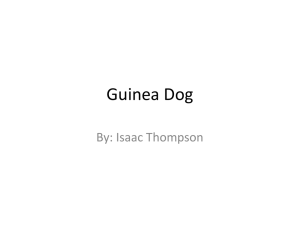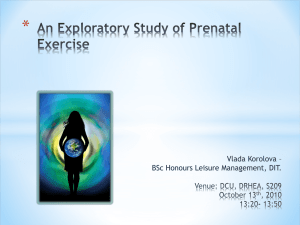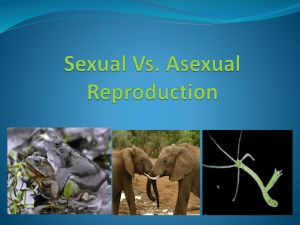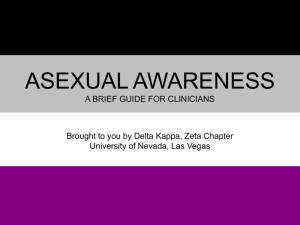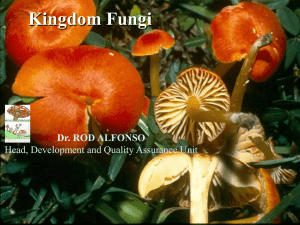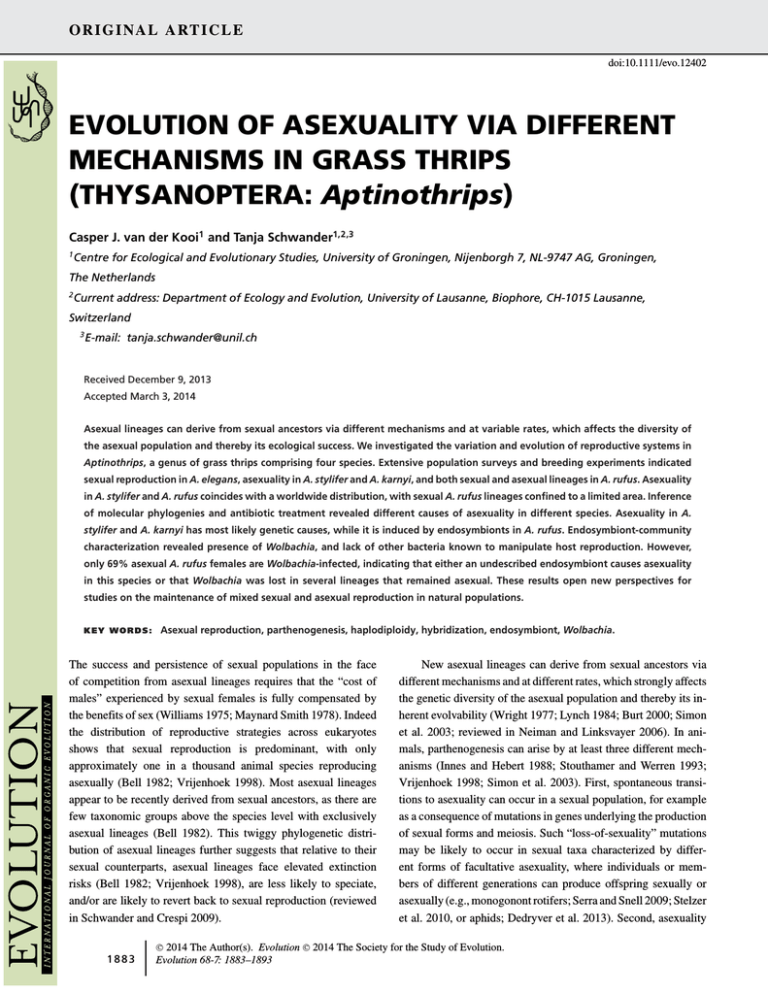
O R I G I NA L A RT I C L E
doi:10.1111/evo.12402
EVOLUTION OF ASEXUALITY VIA DIFFERENT
MECHANISMS IN GRASS THRIPS
(THYSANOPTERA: Aptinothrips)
Casper J. van der Kooi1 and Tanja Schwander1,2,3
1
Centre for Ecological and Evolutionary Studies, University of Groningen, Nijenborgh 7, NL-9747 AG, Groningen,
The Netherlands
2
Current address: Department of Ecology and Evolution, University of Lausanne, Biophore, CH-1015 Lausanne,
Switzerland
3
E-mail: tanja.schwander@unil.ch
Received December 9, 2013
Accepted March 3, 2014
Asexual lineages can derive from sexual ancestors via different mechanisms and at variable rates, which affects the diversity of
the asexual population and thereby its ecological success. We investigated the variation and evolution of reproductive systems in
Aptinothrips, a genus of grass thrips comprising four species. Extensive population surveys and breeding experiments indicated
sexual reproduction in A. elegans, asexuality in A. stylifer and A. karnyi, and both sexual and asexual lineages in A. rufus. Asexuality
in A. stylifer and A. rufus coincides with a worldwide distribution, with sexual A. rufus lineages confined to a limited area. Inference
of molecular phylogenies and antibiotic treatment revealed different causes of asexuality in different species. Asexuality in A.
stylifer and A. karnyi has most likely genetic causes, while it is induced by endosymbionts in A. rufus. Endosymbiont-community
characterization revealed presence of Wolbachia, and lack of other bacteria known to manipulate host reproduction. However,
only 69% asexual A. rufus females are Wolbachia-infected, indicating that either an undescribed endosymbiont causes asexuality
in this species or that Wolbachia was lost in several lineages that remained asexual. These results open new perspectives for
studies on the maintenance of mixed sexual and asexual reproduction in natural populations.
KEY WORDS:
Asexual reproduction, parthenogenesis, haplodiploidy, hybridization, endosymbiont, Wolbachia.
The success and persistence of sexual populations in the face
of competition from asexual lineages requires that the “cost of
males” experienced by sexual females is fully compensated by
the benefits of sex (Williams 1975; Maynard Smith 1978). Indeed
the distribution of reproductive strategies across eukaryotes
shows that sexual reproduction is predominant, with only
approximately one in a thousand animal species reproducing
asexually (Bell 1982; Vrijenhoek 1998). Most asexual lineages
appear to be recently derived from sexual ancestors, as there are
few taxonomic groups above the species level with exclusively
asexual lineages (Bell 1982). This twiggy phylogenetic distribution of asexual lineages further suggests that relative to their
sexual counterparts, asexual lineages face elevated extinction
risks (Bell 1982; Vrijenhoek 1998), are less likely to speciate,
and/or are likely to revert back to sexual reproduction (reviewed
in Schwander and Crespi 2009).
C
1883
New asexual lineages can derive from sexual ancestors via
different mechanisms and at different rates, which strongly affects
the genetic diversity of the asexual population and thereby its inherent evolvability (Wright 1977; Lynch 1984; Burt 2000; Simon
et al. 2003; reviewed in Neiman and Linksvayer 2006). In animals, parthenogenesis can arise by at least three different mechanisms (Innes and Hebert 1988; Stouthamer and Werren 1993;
Vrijenhoek 1998; Simon et al. 2003). First, spontaneous transitions to asexuality can occur in a sexual population, for example
as a consequence of mutations in genes underlying the production
of sexual forms and meiosis. Such “loss-of-sexuality” mutations
may be likely to occur in sexual taxa characterized by different forms of facultative asexuality, where individuals or members of different generations can produce offspring sexually or
asexually (e.g., monogonont rotifers; Serra and Snell 2009; Stelzer
et al. 2010, or aphids; Dedryver et al. 2013). Second, asexuality
C 2014 The Society for the Study of Evolution.
2014 The Author(s). Evolution Evolution 68-7: 1883–1893
C . J. VA N D E R KO O I A N D T. S C H WA N D E R
may be caused by hybridization, documented mainly in vertebrates (Schultz 1973; Moritz et al. 1989; Neaves and Baumann
2011). Finally, asexuality may be induced through infection by
endosymbionts, the best known being Wolbachia and Cardinium
(Stouthamer and Werren 1993; Zchori-Fein et al. 2001; Weeks
et al. 2003; Zchori-Fein and Perlman 2004; Werren et al. 2008).
These endosymbionts are transmitted by females to their offspring through the egg cytoplasm. Because only females contribute cytoplasm to the next generation, the endosymbionts benefit from inducing hosts to allocate most or all resources to the
production of daughters (reviewed in Breeuwer and Jacobs 1996;
Werren et al. 2008). Endosymbiont-induced asexuality is best
documented in parasitoid wasps, where bacterial infection has
been linked to their haplodiploid sex determination system (e.g.,
Werren et al. 2008; Cordaux et al. 2011). Haplodiploidy is characterized by the development of males from unfertilized (haploid) eggs and females from fertilized (diploid) eggs. Unfertilized
eggs laid by endosymbiont-infected females undergo diploidization in the absence of fertilization with sperm and develop into
females.
Here, we investigate the evolution of asexuality in grass
thrips (genus Aptinothrips). Similar to parasitoid wasps (and hymenopterans in general), sexual thrips species are characterized
by haplodiploid sex determination (Lewis 1973). Asexual reproduction has been suggested to be widespread among thrips, as
many species display strongly female-biased population sex ratios or are even only known from females (e.g., Lewis 1973;
Mound and Masumoto 2009). However, the potential for asexual
reproduction has thus far only been investigated in a handful of
species (Arakaki et al. 2001; Nault et al. 2006; Kumm and Moritz
2008). The genus Aptinothrips comprises four wingless species:
A. rufus, A. elegans, A. stylifer, and A. karnyi (Palmer 1975). For
A. rufus, A. stylifer, and A. elegans males have been reported but
can be very rare locally (Sharga 1933; Palmer 1975), such that
their role for reproduction remains unclear (Sharga 1933). For A.
karnyi no males are known (Palmer 1975), suggesting this species
is asexual.
We first conducted extensive Aptinothrips population surveys
and breeding experiments using field samples from 16 different
countries, to describe population sex ratios and to characterize the
reproductive modes occurring in the genus. We then investigated
the relationships between species and lineages with different reproductive modes via inference of molecular phylogenies based
on nuclear and mitochondrial markers. Finally, to test for potential origins of asexuality through endosymbiont infection, we
screened grass thrips for endosymbionts known to manipulate host
reproduction and treated females of asexual grass thrips lineages
with antibiotics.
1884
EVOLUTION JULY 2014
Material and Methods
The grass thrips genus Aptinothrips is native to Europe, but the
species A. rufus and A. stylifer have been reported throughout the
world (Palmer 1975; Mound and Masumoto 2009). Aptinothrips
species are small (< 1.5 mm) and occur on a variety of grasses
(Poaceae family), with little or no information available on potential host specificity (Lewis 1973; Palmer 1975). To survey
Aptinothrips field populations, we collected thrips from various
grasslands from over 100 locations throughout Europe and the
United States between February 2012 and June 2013. Details for
the 100 locations at which we found Aptinothrips are given in the
Supplementary Table 1. We used two different sampling strategies to determine the sex ratio of adult thrips in the field or to
collect individuals for breeding experiments. Samples for determination of adult sex ratios were collected by beating grass tufts
over a collecting tray and by preserving the content of the tray in
alcohol. The alcohol-preserved material from the tray was then
sorted in the laboratory, and all thrips (larvae and adults) were
isolated from other arthropods and plant materials under a dissecting scope at 20–50× magnification. This strategy assures that
no sex ratio bias is introduced artificially by preferentially collecting females, which are larger and more conspicuous than males.
Among all the collected thrips, we isolated adult Aptinothrips, and
identified species and sex for each individual following Palmer
(1975) and Zur Strassen (2003) to determine the sex ratio among
adults. Individuals for breeding experiments were either beaten
from grass tufts onto a white collecting tray and picked up with a
small paintbrush, or isolated from cut grass in the laboratory.
To determine the mode of reproduction characterizing each
Aptinothrips species, Aptinothrips larvae of unknown sex (it is
not possible to distinguish sexes or Aptinothrips species in larvae) collected in the field were isolated individually in a “cage” (a
sealed 50 ml plastic tube or 3 dl cup), containing a wheat plantlet.
This assured that all females used in breeding experiments were
virgins—adult females collected in the field might have mated
already. The larvae that reached maturity and turned out to be
female were allowed to produce offspring. Asexual reproduction
is then indicated by a virgin female producing only daughters. By
contrast, sexual virgin females would produce sons, since under
haplodiploidy, unfertilized eggs develop into males. The generation time for A. rufus was estimated to be approximately 40 days
at room temperature (Sharga 1932); we therefore started checking
for adult offspring in each cage after four weeks of maintaining
the cages at 20°C ± 2 under a light regime of L:D = 16:8. When
adults were spotted, cages were emptied completely to determine
the number of larvae, males, and females present. Excluding all
cages initiated with larvae that did not reach adulthood or that
E VO L U T I O N O F A S E X UA L I T Y I N G R A S S T H R I P S
Figure 1.
Distribution and adult sex ratios of (A) Aptinothrips elegans (B) A. stylifer, and (C) A. rufus populations in the surveyed range.
A. karnyi is not displayed as this species only occurred in three locations in Switzerland. Geographically close locations were fused for
easier display; a complete list of locations with numbers of individuals sampled is provided in the Supplementary Table 1.
developed into males, we obtained 238 cages with virgin females
for which we could determine the mode of reproduction.
Molecular Sequence Analyses
To infer phylogenetic relationships between different Aptinothrips
lineages we used 1–6 individuals from 68 locations, for a total of
159 individuals (114 A. rufus, 26 A. stylifer, 14 A. elegans, and
5 A. karnyi, see Supplementary Table 1 for details). A subset of
these individuals (58 in total; 15 A. stylifer females, 6 A. elegans
males, and 37 A. rufus) came from locations where we did not
directly infer the reproductive mode of individuals via breeding
experiments. Males in these uncharacterized samples were considered sexual and A. stylifer females were considered asexual
as there was no indication for sexual reproduction in this species
(see results). Twenty-eight A. rufus females from Belgium and the
Netherlands were also considered asexual because they were collected from female-only populations in a very densely surveyed
region with many populations in which asexual reproduction was
inferred via breeding experiments (see Fig. 1). For the remaining nine A. rufus females (two from Poland, two from Finland,
three from Germany, and two from Denmark) the reproductive
mode is unknown. DNA from each individual was extracted using the QIAGEN tissue extraction kit (QIAGEN Inc.) according
to the manufacturer’s protocol. After extraction, the exoskeleton
of each individual was stored in ethanol as a voucher.
We sequenced portions of one mitochondrial gene (COI,
650 bp), one nuclear gene (Histone H3, 454 bp), and the nuclear 28S rRNA (350 bp), using previously published primer pairs
(Table 1). The following PCR conditions were used for all primer
combinations: each reaction contained 5 μl extracted DNA template, 2.5 μl 10× buffer, 2.0 μl dNTP (2.5 μM), 2.5 μl MgCl2
(2.5 μM), 0.5 μl of each primer (10 μM), 0.6 μl Taq (250 units)
and were completed to 25 μl using nanopure water. Cycling conditions were as follows: 1× 5 min 95 C; 35× 40 sec 95 C, 40 sec
50 C, 40 sec 72 C; 1× 7 min 72 C. Nanopure water was always
included as negative control. Five microliters of the PCR-product
was run on an ethidiurnbromide-stained, 1% agarose gel. Products
that showed the expected size were purified using ExoSap-IT according to the manufacturer’s protocol (Isogen Life Science B.V.,
De Meem, The Netherlands). Five microliters purified PCR product was combined with 5 μl forward or reverse primer (5 μM)
and sent to GATC Biotech, Germany (www.gatc-biotech.com)
for sequencing. The sequences have been deposited in GenBank with the accession numbers KJ459552–KJ459710 for COI,
KJ459393–KJ459551 for H3, and KJ436391–KJ436566 for 28S.
Nucleotide sequences were aligned using ClustalX
(Thompson et al. 1994) via the BioEdit Sequence Alignment Program version 7.1.3 (www.mbio.ncsu.edu/BioEdit/bioedit.html).
Maximum likelihood phylogenetic analyses (with heuristic tree
searches) and topology tests were carried out using PAUP∗4.0b10
(Swofford 1993, 2000) on Bioportal (www.bioportal.uio.no),
using Aeolothrips as an outgroup. We used the optimal model
of sequence evolution identified with the Akaike information
criterion (AIC) as implemented in jMODELTEST 0.1.1 (Posada
2008). Branch support in the full phylogenies was evaluated by
a maximum-likelihood/parsimony bootstrapping analysis using
Seqboot (500 replicates), DNAml respectively DNApars, and
Consense within the Phylip 3.68 package (Felsenstein 1993).
Bayesian posterior probabilities were inferred with MrBayes3.1.2
EVOLUTION JULY 2014
1885
C . J. VA N D E R KO O I A N D T. S C H WA N D E R
Table 1.
Information for primers used in molecular analyses.
Locus: Primer pair
(forward; reverse)
Forward primer sequence
Reverse primer sequence
Reference
COI:
(mtD7.2F; CI-N-2329)
ATTAGGAGCHCCHGAYATAGCATT
ACTGTAAATATATGATGAGCTCA
(Simon et al. 1994;
Brunner et al. 2002)
TAAACTTCAGGGTGACCAAAAAATCA
GGTCAACAAATCATAAAGATATTGG
(Simon et al. 1994)
ATGGCTCGTACCAAGCAGAC
ATATCCTTRGGCATRATRGTGAC
(Glover et al. 2010)
GACCCGTCTTGAAMCAMGGA
TCGGARGGAACCAGCTACTA
(Inoue and Sakurai
2007)
COI:
(HCO-2198; LCO-1490)
Histone H3:
(H3NF; H3R)
28S rRNA:
(28SS; 28SA)
(Huelsenbeck and Ronquist 2001; Ronquist and Huelsenbeck
2003), with Markov chains run for 106 generations, 104 generations burn-in values, and trees sampled every 100 generations.
Trees were formatted with FigTree version 1.4 (Rambaut 2012).
ANTIBIOTIC TREATMENT AND ENDOSYMBIONT
SCREENS
The population surveys and breeding experiments revealed asexual reproduction in three of the four Aptinothrips species (see
Results). To test whether asexuality in these species is caused
by infection with endosymbionts, a subset of thrips was treated
with the broad-spectrum antibiotic tetracycline (Sigma, St. Louis
MI) and the offspring sex ratio produced by treated thrips females was compared to the sex ratio produced by females of a
control group. We used different strategies to treat the females,
as we did not have any prior knowledge of what type of treatment would be effective in removing putative endosymbionts.
First, females were isolated in groups of 5 for 18–24 h in a 1.5
ml eppendorf tube with a paper towel soaked in grass juice containing 50 mg/ml tetracycline. Females of the control group were
isolated similarly but without tetracycline dissolved in the grass
juice. Grass juice was obtained by blending wheat plants (grown
in the laboratory) with demineralized water. The females were
then transferred to cages (similar to those used in the breeding
experiments), with five treated or five untreated females per cage.
Twenty-four hours later, cages containing treated females were
sprayed with tetracycline dissolved in water (50 mg/ml), control cages were sprayed with water. This treatment was repeated
once per week for six weeks. Cages were opened 5–7 weeks after
introducing the females to determine the number and sex ratio
of adult individuals present. Out of 55 cages started with five
females, 47 yielded offspring (30 A. rufus, 14 A. stylifer, 3 A.
karnyi). For each species, we compared the production of males
between treatment and control cages using GLM with a quasibinomial error distribution using R 2.13.0 (R development core
team, 2011).
1886
EVOLUTION JULY 2014
Given that the antibiotic treatments revealed evidence of
endosymbiont-induced asexuality at least in some A. rufus females (see results), we screened the endosymbiont communities
of two sexual (sexual A. rufus and A. elegans) and two asexual
(asexual A. rufus and A. stylifer) lineages for bacteria associated
with reproductive manipulation (reviewed in Duron et al. 2008;
Kageyama et al. 2012): Wolbachia, Cardinium, Ricksettia, Spiroplasma, Flavobacteria, Arsenophonus (note that only the first
three are known to induce asexuality). For each of the four lineages, we pooled 20–60 individuals from at least three separate
populations and extracted genomic DNA as described above. Prior
to DNA extraction, samples were surface sterilized by washing
them in 10% bleach for 30 sec and rinsed in 95% ethanol to remove residual bleach before DNA extraction. We then amplified
520 bp of the bacterial 16S rRNA region with general primers
(Univ9F: GAGTTTGATYMTGGCTC and BR534/18: ATTACCGCGGCTGCTGGC; Wilmotte et al. 1993) for each of the four
population pools. The purified 16S rRNA amplicons were sent to
a commercial facility (GATC Biotech, Konstanz, Germany) for
FLX 454 pyrosequencing (1/16 plate). Sequencing reads were analyzed with the QIIME (Caporaso et al. 2010) core analyses script
(core_qiime_analyses.py) using default parameters, OTU tables
were summarized at different taxonomic levels using a second
QIIME script (summarize.taxa.py).
The 16S amplicon screen revealed only Wolbachia as a candidate for asexuality induction in grass thrips; we did not find any
of the other bacteria previously reported to manipulate reproduction in arthropod hosts (see Results). We therefore tested the grass
thrips individuals used for phylogenetic inference, and additional
104 individuals (total 263), for Wolbachia infection, by amplifying a Wolbachia-specific surface protein (WSP). Since primers
may vary in their ability to detect different Wolbachia strains
(Baldo et al. 2006), two different sets of primers were used, following the published PCR conditions in each case: WSP-F and
WSP-R from Jeyaprakash and Hoy (2000), amplifying 600 bp,
and WSP-F236 and WSP-R446 from Braig et al. (1998), amplifying 210 bp. Five microliters of the PCR-product were run
E VO L U T I O N O F A S E X UA L I T Y I N G R A S S T H R I P S
on an ethidiumbromide stained 1% agarose gel. A sample was
considered positive for Wolbachia if a PCR with one of the two
WSP primer pairs generated a band of the expected size on the
gel. Positive controls (initially, the asexual A. rufus extraction
used for the 16S screen, later samples tested positive in previous PCRs) and negative controls (nanopure water) were always
included. Wolbachia-negative samples were tested at least twice
and up to six times with each primer pair.
Results
tional location (“Plateau des Tailles,” Supplementary Table 1)
most likely also comprises only asexual females. We found only
two males among 150 females at this location, but it is currently not possible to test whether these males are indicative
of rare sexual lineages or whether they represent developmental “accidents”—rare males are known to be produced by many
obligately asexual lineages (see Discussion). A. rufus females at
the three remaining locations, clustered at the south-western end
of the surveyed area (southern Spain and Portugal, Fig. 1C), reproduced exclusively sexually. Adult males were found at each of
the locations (sex ratios respectively 0.20, 0.26, and 0.33) and all
26 females reared in isolation produced only sons.
POPULATION SURVEYS AND REPRODUCTIVE MODES
We found different Aptinothrips species at 100 locations spread
over 16 countries (Supplementary Table 1, Fig. 1A–C). Samples from most locations (82%) comprised only one Aptinothrips
species, but we also found two species (15% of the locations),
or even three (3%), co-occurring together. The most widespread
species is A. rufus, which we found at 87 locations (15 countries). A. elegans occurred at nine southern locations (Fig. 1A). A.
karnyi was very rare in the surveyed area as it was only found in
Switzerland (three locations). Aptinothrips is a genus of European origin (Palmer 1975), but we found introduced populations in the United States of A. rufus, A. stylifer, and A. elegans,
whereby A. elegans was thus far not known to occur in the United
States.
We found no evidence for asexual reproduction in A. elegans
at the nine locations where this species occurred. Males occurred
at all nine locations, with the sex ratio among field-collected
adults ranging from 0.17 to 0.5 (Supplementary Table 1, Fig. 1A).
All 29 female larvae reared in isolation produced only sons after
reaching adulthood, as expected under sexual reproduction and
haplodiploidy. While it is possible that this species may reproduce
asexually at other locations, or that some locations comprise rare
asexual lineages among the sexual ones, the predominant mode of
reproduction in the surveyed area appears to be sexual. Sexuality
in A. elegans is in contrast to the three other Aptinothrips species
that, as explained below, appear to reproduce mostly (A. rufus) or
exlusively (A. stylifer and A. karnyi) asexually.
We did not find a single male at any of the locations comprising A. stylifer (22 locations, 233 adult females) or A. karnyi
(three locations, 28 females). For both species, females collected
as larvae and reared in isolation produced only daughters (40
A. stylifer females and six A. karnyi females tested), corroborating asexual reproduction suggested by the female-only natural
populations.
For A. rufus, females at 83 out of the 87 locations were found
to reproduce exclusively asexually. Not a single adult male was
found in the field among over 3000 females and all 137 virgin
females reared in isolation produced only daughters. One addi-
APTINOTHRIPS SPECIES RELATIONSHIPS AND
TRANSITIONS TO ASEXUALITY
Our genetic analyses supported the distinction of the four
Aptinothrips species as they were described using morphological criteria (Palmer 1975). However, the relative grouping of the
species, while consistent between the mitochondrial gene COI and
the nuclear gene H3 (Kishino–Hasegawa topology test: P = 0.48),
differed significantly for the noncoding 28S locus (Kishino–
Hasegawa topology test: P < 0.001). The different topologies
were due to A. stylifer sharing similar or even identical 28S sequences with A. elegans individuals, while this species was clearly
differentiated from A. elegans at the two other markers and also
more closely related to A. rufus than to A. elegans (Fig. 2).
Independently of whether the Aptinothrips species tree is
better represented by the topology of the COI-H3 gene tree or the
28S tree, both topologies indicate that transitions to asexuality
within A. rufus would have occurred independently of the transition leading to A. stylifer and A. karnyi. In both cases, a tree for
which we constrained all asexual groups to be monophyletic was
a significantly poorer fit to the data than the unconstrained tree
(Templeton tests, all P < 0.0001; Shimodaira–Hasegawa tests, all
P < 0.0001).
Within A. rufus, the tree topologies obtained with each individual or concatenated loci were very similar (Kishino–Hasegawa
topology test: all P > 0.45) and revealed three differentiated
clades, one comprising only individuals from the sexual populations and two reciprocally monophyletic clades of asexual individuals (Fig. 2; topology tests conducted with all three loci
concatenated: Templeton test, P < 0.001; Shimodaira–Hasegawa
test, P < 0.001). Eight of the nine A. rufus females for which
the mode of reproduction was not known clustered together with
84 asexual individuals in A. rufus clade I, the ninth individual
clustered with six asexual individuals in clade III (Fig. 2). The
topology of the A. rufus subtree thus indicates either at least
two independent transitions to asexuality in A. rufus, or one
transition to asexuality followed by a reversal back to sexual
reproduction.
EVOLUTION JULY 2014
1887
1888
EVOLUTION JULY 2014
Figure 2.
Aptinothrips phylogeny based on (A) concatenated COI and Histone H3 sequences and (B) 28S sequences. Asexual species and lineages are displayed in red, the size
female, from Nawa, Poland for which the reproductive mode was not tested in breeding experiments (Supplementary Table 1). Clade I comprises eight such females, including
one from Nawa. (C) Minimum spanning network based on COI sequences indicating the genetic divergence within and between groups, inferred in Arlequin 3.5.1.3 (Excoffier and
Lischer 2010). The length of the branches separating haplotypes is proportional to the number of mutations separating them (scale indicates length for 40 mutations).
of the triangles is proportional to the genetic diversity in each clade. For each clade, the total number of individuals (ind) and the percentage of Wolbachia-infected individuals
(infected) is indicated in square brackets (for A. rufus, percentages only refer to individuals used in the phylogeny, for the other species percentages are based on all tested
individuals). Numbers at branches indicate bootstrap support for maximum likelihood and parsimony and Bayesian posterior probabilities. Clade III of A. rufus comprises one
C . J. VA N D E R KO O I A N D T. S C H WA N D E R
E VO L U T I O N O F A S E X UA L I T Y I N G R A S S T H R I P S
ANTIBIOTIC TREATMENT AND ENDOSYMBIONT
SCREENS
Antibiotic treatments revealed that asexuality is induced by bacterial endosymbionts in A. rufus but most likely not in A. stylifer
or A. karnyi. All groups of A. rufus females fed with antibiotics
produced at least some male offspring (14 out of 14 cages), no
males were produced by untreated groups of females (0 out of
16 cages), with treatment cages being significantly more likely
to yield males than control cages (t = 135, P < 0.0001). The
proportion of males produced by females in the treatment cages
varied widely (0.09–0.81), but offspring comprised individuals
of both sexes in each cage. For the two other species, no males
were found among the offspring of either the treated or untreated
female groups (A. stylifer: seven control and seven test cages, t =
0.63, P = 0.54; A. karnyi: one control and two test cages, t =
0.03, P = 0.98).
Given the evidence for endosymbiont-induced asexuality in
A. rufus, we screened bacterial communities of asexual and sexual A. rufus population pools, as well as of A. stylifer and A.
elegans populations, for the presence of endosymbionts known to
manipulate reproduction in other arthropods. A. karnyi was not
included because we did not have enough individuals available.
16S amplicon sequencing of each of the four samples produced
combined 45,842 reads longer than 200 bp, representing 919 different bacterial strains. Blast searches revealed that 42 of these
strains corresponded to Wolbachia. No similarity to other bacterial endosymbionts associated with reproductive manipulation
was found for the remaining strains.
Forty of the 42 Wolbachia strains were from the pooled A.
rufus asexual populations, where Wolbachia accounted for the
majority (71%) of reads. This indicates that Wolbachia is the
dominant endosymbiont in asexual A. rufus. The two remaining
Wolbachia strains were from the pooled A. stylifer (one strain,
0.01% of the reads) and A. elegans populations (one strain, 0.02%
of all reads). Not a single Wolbachia sequence was found among
the 11,965 reads from the pooled sexual A. rufus populations.
The abundance of Wolbachia in the endosymbiont communities of asexual A. rufus prompted us to screen a subset of 263
individuals (including the 159 used for phylogenetic analyses)
from different locations for Wolbachia infection via PCR assays.
These screens revealed variable infection with Wolbachia, both
between and within species, that were loosely associated with
reproductive mode. For the sexual species A. elegans, four out of
23 tested females were infected with Wolbachia (17%), all four
from the same location (La Sarraz). Interestingly, this population
corresponds to the one with the most strongly female-biased sex
ratio among all A. elegans populations surveyed (Supplementary
Table 1). Two additional females from the same location were
not infected. Only one of the five tested A. karnyi females and 16
out of 45 A. stylifer females (36%) were infected with Wolbachia
without any particular geographic pattern relative to the distribution of infected or noninfected individuals. For the asexual A.
rufus, 67% of the individuals were infected (111 out of 166) with
infection rates varying among clades. Asexual A. rufus of clade I
had the highest infection rate (70%, Fig. 2A). Given this clade is
characterized by very low genetic diversity (Fig. 2C), the incomplete infection suggests either recent infection with Wolbachia or
recent loss of infection. Interestingly, none of the seven asexual
A. rufus individuals of the clade most closely related to the sexual
A. rufus was infected with Wolbachia (clade III, Fig. 2). Similarly, not a single one of the 24 tested sexual A. rufus females
were infected. The partial (or complete lack of) infections are unlikely to stem from technical errors. The systematic use of positive
controls in PCR assays and repeated tests for Wolbachia-negative
individuals (4–6 independent assays, including tests with different primer sets) make false negatives as a consequence of PCR
failures highly unlikely.
In summary, sexual populations of Aptinothrips are generally not infected with Wolbachia (except for A. elegans in La
Sarraz, where it remains to be confirmed whether there could be
a mix of sexual and infected asexual individuals). The majority
of asexual A. rufus females are infected with Wolbachia (67%),
and antibiotic treatment reveals that asexuality is induced by endosymbionts in at least a subset of these females. Only a minority
of asexual A. karnyi (1 out of five) and A. stylifer (36%) females
are infected with Wolbachia and antibiotic treatment of females
in these species did not induce the production of males. No other
endosymbionts known to manipulate reproduction in arthropods
were uncovered in the endosymbiont communities of A. rufus, A.
stylifer, and A. elegans.
Discussion
Our study shows that the genus Aptinothrips comprises both sexual and asexual species and populations. Across the surveyed
locations, A. elegans and the southern Spain and Portugal A. rufus
populations are characterized by exclusively sexual reproduction,
even though sex ratios are generally female biased. Female-biased
population sex ratios are characteristic of many thrips species, and
have largely been explained by males being short lived (Lewis
1973). In the remaining A. rufus populations, as well as in A.
karnyi and A. stylifer, females reproduce asexually. The distribution of A. karnyi appears to be very limited, with records confined
to the Alps and one report from Nepal (Palmer 1975, this study).
The three remaining Aptinothrips species are geographically very
widespread. The sexual species A. elegans occurs at least throughout Europe and in one location in the United States, whereas A.
stylifer and especially A. rufus have as a minimum a Holarctic,
if not worldwide, distribution (Palmer 1975; Zur Strassen 2003;
Hoddle et al. 2012; this study). Given this widespread occurrence
EVOLUTION JULY 2014
1889
C . J. VA N D E R KO O I A N D T. S C H WA N D E R
of A. rufus, the very limited distribution of sexual A. rufus populations, confined to southern Spain and Portugal, indicates that
asexuality is a very successful strategy in this species. Asexuality
may either have allowed the colonization of a vast geographic
range inaccessible to sexual A. rufus lineages, or asexual lineages would have largely or completely outcompeted their sexual
counterparts across most of the range. Indeed we found no evidence for sexual and asexual A. rufus lineages forming locally
mixed populations. Asexual A. rufus lineages co-occur, however,
with the asexual A. stylifer as well as with the sexual species A.
elegans, raising the question of what mechanisms allow for the
maintenance of reproductive polymorphisms among these closely
related species.
We cannot formally exclude the hypothesis that that rare
sexual lineages persist in largely asexual populations as we found
occasional males in otherwise asexual populations of A. rufus
and as males have also been reported for A. stylifer (Sharga 1933;
Palmer 1975; this study). However, given the very sporadic occurrence of such males in populations with no evidence for sexual
reproduction among females, it appears more likely that these
males are produced “accidentally” by asexual females. Such accidental production of males is known for many, if not most,
obligately asexual lineages, where males represent vestiges of a
formerly sexual lifestyle and typically have no mating opportunities or success in natural populations (recently reviewed in van
der Kooi and Schwander 2014).
The production of occasional males by asexual females is
especially widespread among lineages in which asexuality is
induced by infection with endosymbionts (van der Kooi and
Schwander 2014), possibly because of incomplete endosymbiont
transmission to offspring or failed manipulation of host reproduction (Reumer et al. 2012). Consistent with this pattern, asexuality in A. rufus is caused by endosymbionts. Indeed, treatment
of asexual A. rufus females with the antibiotic tetracycline induced the production of males, as reported for other species
with haplodiploid sex determination. For example, endosymbiontinduced asexuality is well-known among parasitoid wasps (e.g.,
Stouthamer et al. 1990; Zchori-Fein et al. 1992; Werren et al.
1995; Pijls et al. 1996; Kremer et al. 2009) and has also been
documented in mites (e.g., Breeuwer and Jacobs 1996; Groot
and Breeuwer 2006; Ros et al. 2008). Among thrips, it has previously been reported for Franklinothrips vespiformis (Arakaki
et al. 2001) and Hercinothrips femoralis (Kumm and Moritz
2008). Antibiotic treatment generally causes asexual females to
produce only sons. In A. rufus however, antibiotic-treated females still produced daughters in addition to sons, as previously reported in Hercinothrips femoralis (Kumm and Moritz
2008). Mixed progeny may indicate incomplete removal of the
endosymbionts, whereby only individuals with very few or no endosymbionts develop into males. However, because we treated and
1890
EVOLUTION JULY 2014
maintained females in groups of five, it is currently not possible to
say whether all females produced daughters and sons, or whether
antibiotic treatment does not induce male production in a subset
of females.
The combination of male induction via antibiotic treatment
and evidence for infection with Wolbachia (or another endosymbiont known to induce asexuality in some species) is usually interpreted as evidence for the endosymbiont inducing asexuality in
a species (e.g., Pijls et al. 1996; Arakaki et al. 2001; Zchori-Fein
et al. 2001; Kumm and Moritz 2008; Kremer et al. 2009). Such
interpretations should be considered with caution, as Wolbachiainfection is very widespread, including among species with sexual reproduction (Duron et al. 2008; Hilgenboecker et al. 2008;
Zug and Hammerstein 2012). In A. rufus, the characterization of
endosymbiont communities via 16S sequencing revealed evidence
for Wolbachia infection, and lack of infection with any other endosymbiont known to induce asexuality. This may suggest that
Wolbachia also induces asexuality in A. rufus. However, in contrast to previous studies where typically only one or a few strains
were tested for endosymbiont infection, we screened many asexual A. rufus individuals from a broad geographic range. This
screen revealed that less than 70% asexual A. rufus females are
infected, indicating that either a different, currently unknown, endosymbiont causes asexuality in A. rufus or that Wolbachia has
been lost in a number of strains that remained asexual in the absence of infection. Consistent with the latter hypothesis, one clade
of A. rufus (clade III consisting of seven individuals, Figure 2) was
completely uninfected. However, most asexual A. rufus females
belong to clade I (n = 93), in which 30% of individuals were
also uninfected, indicating that there would have been multiple
losses of endosymbionts with maintenance of asexuality. Such
losses would have occurred very recently given this clade is characterized by very low genetic diversity (Fig. 2C).The possibility
that asexuality has been maintained, for example via transfer of
asexuality-inducing elements from the Wolbachia genome into
the host genome, is currently being investigated. Independently
of the mechanism accounting for incomplete Wolbachia infection in asexual A. rufus, the geographic distributions of infection
prevalence or asexual lineage representation had no apparent pattern. Most locations comprised individuals from different asexual
clades with a subset of them being uninfected, indicating extensive
dispersal for all categories of asexual A. rufus.
The reciprocal monophyly of the two A. rufus clades consisting of asexual individuals, and their positioning relative to sexual
A. rufus, indicates either two independent transitions to asexuality
from a sexual ancestor, or one transition to asexuality followed by
a reversal to sexual reproduction. These two alternatives cannot
be distinguished with the currently available data. Reversals from
asexual to sexual reproduction are generally considered to be impossible, since sexuality is assumed to be a complex trait which is
E VO L U T I O N O F A S E X UA L I T Y I N G R A S S T H R I P S
highly unlikely to reevolve once it is lost (Bull and Charnov 1985).
However, cases of endosymbiont-induced asexuality appear to be
an exception to this rule (Stouthamer et al. 1990; van der Kooi
and Schwander 2014). This may be because in contrast to other
forms of asexuality, endosymbiont-induced asexuality does not
require genetic changes in the host, such that reversals may be
possible, at least in recently infected lineages (van der Kooi and
Schwander 2014).
In contrast to A. rufus, there is no evidence that asexuality
in A. stylifer and A. karnyi is caused by infection with endosymbionts. Treatment with broad-spectrum antibiotics did not induce
the production of males, and we found low infection rates with
Wolbachia, and no evidence for any other endosymbiont known to
induce asexuality. Consistent with different mechanisms leading
to asexuality in A. rufus versus A. stylifer and A. karnyi, phylogenetic analyses indicate that the transition to asexuality in A.
stylifer and A. karnyi is independent from transitions to asexuality in A. rufus (Fig. 2). While we cannot formally exclude the
hypothesis that other, unknown, endosymbionts that are insensitive to the applied treatments induce asexuality in A. stylifer
and A. karnyi, the current evidence suggests that asexuality in
these two species has genetic causes. Furthermore, the sharing of
closely related 28S haplotypes between A. stylifer and A. elegans
(Fig. 2B) suggests recent gene flow from A. elegans into A. stylifer
that may be indicative of hybridization contributing to the split
between A. stylifer and A. karnyi. Independently of the mechanisms that caused this split, the fact that there are two asexual
sister species suggests that speciation would have occurred after
the transition to asexuality, a rarely observed pattern in asexual
lineages (Fontaneto et al. 2007).
In conclusion, our study reveals multiple transitions to asexuality that occurred via different mechanisms in a genus consisting
only of four species. Endosymbiont-induced asexuality in A. rufus
but incomplete infection with Wolbachia suggests either recurrent losses of infection or that a yet unknown endosymbiont may
cause asexuality in this species, and highlights the importance
of conducting species-wide screens for endsymbiont-infection
when identifying bacterial candidates underlying the induction
of parthenogenesis. Finally, Aptinothrips species and lineages
with different reproductive modes co-occur together locally or
at least at geographically close locations, raising the question of
the mechanisms maintaining reproductive polymorphism in the
genus Aptinothrips and opening new perspectives for studies on
the maintenance of mixed sexual and asexual reproduction in
natural populations.
ACKNOWLEDGMENTS
We thank Giovanni Iacca, Ivonne Schep, Jorien Rippen, Kim Meijer,
Marin van Regteren, Ricardo Geertsema, Rik Veldhuis, Silvia Paolucci,
Wanda Reen, and many other people who collected samples for us,
Zo´e Dumas for support with labwork and Bart Zijlstra for thrips
pictures and figure editing. This work was supported by funding from
the NWO (Veni grant no. 863.09.001), and by funding from the SNSF
(grant PP00P3 139013) to TS.
LITERATURE CITED
Arakaki, N., T. Miyoshi, and H. Noda. 2001. Wolbachia-mediated
parthenogenesis in the predatory thrips Franklinothrips vespiformis
(Thysanoptera: Insecta). Proc. Roy. Soc. B 268:1011–1016.
Baldo, L., J. C. D. Hotopp, K. A. Jolley, S. R. Bordenstein, S. A. Biber,
R. R. Choudhury, C. Hayashi, M. C. J. Maiden, H. Tettelin, and J. H.
Werren. 2006. Multilocus sequence typing system for the endosymbiont
Wolbachia pipientis. Appl. Environ. Microbiol. 72:7098–7110.
Bell, G. 1982. The masterpiece of nature. The evolution and genetics of
sexuality. University of California Press, Berkeley, CA.
Braig, H. R., W. G. Zhou, S. L. Dobson, and S. L. O’Neill. 1998. Cloning
and characterization of a gene encoding the major surface protein of
the bacterial endosymbiont Wolbachia pipientis. J. Bacteriol. 180:2373–
2378.
Breeuwer, J. A. J., and G. Jacobs. 1996. Wolbachia: Intracellular manipulators
of mite reproduction. Exp. Appl. Acarol. 20:421–434.
Brunner, P. C., C. Fleming, and J. E. Frey. 2002. A molecular identification
key for economically important thrips species (Thysanoptera: Thripidae)
using direct sequencing and a PCR-RFLP-based approach. Agric. For
Entomol. 4:127–136.
Bull, J. J., and E. L. Charnov. 1985. On irreversible evolution. Evolution
39:1149–1155.
Burt, A. 2000. Perspective: sex, recombination, and the efficacy of selection—
was Weismann right? Evolution 54:337–351.
Caporaso, J. G., J. Kuczynski, J. Stombaugh, K. Bittinger, F. D. Bushman, E.
K. Costello, N. Fierer, A. G. Pena, J. K. Goodrich, J. I. Gordon, et al.
2010. QIIME allows analysis of high-throughput community sequencing
data. Nat. Meth. 7:335–336.
Cordaux, R., D. Bouchon, and P. Greve. 2011. The impact of endosymbionts
on the evolution of host sex-determination mechanisms. Trends Genet.
27:332–341.
Dedryver, C. A., J. F. Le Gallic, F. Maheo, J. C. Simon, and F. Dedryver.
2013. The genetics of obligate parthenogenesis in an aphid species and
its consequences for the maintenance of alternative reproductive modes.
Heredity 110:39–45.
Duron, O., D. Bouchon, S. Boutin, L. Bellamy, L. Q. Zhou, J. Engelstadter,
and G. D. Hurst. 2008. The diversity of reproductive parasites among
arthropods: Wolbachia do not walk alone. BMC Biol. 6:27.
Excoffier, L., and H.E. L. Lischer. 2010. Arlequin suite ver 3.5: a new series
of programs to perform population genetics analyses under Linux and
Windows. Mol. Ecol. Res. 10:564–567.
Felsenstein, J. 1993. PHYLIP (Phylogeny Inference Package) version 3.5c.
Department of Genetics, University of Washington, Seattle.
Fontaneto, D., E. A. Herniou, C. Boschetti, M. Caprioli, G. Melone, C. Ricci,
and T. G. Barraclough. 2007. Independently evolving species in asexual
bdelloid rotifers. PLoS Biol. 5:914–921.
Glover, R. H., D. W. Collins, K. Walsh, and N. Boonham. 2010. Assessment of
loci for DNA barcoding in the genus Thrips (Thysanoptera: Thripidae).
Mol. Ecol. Res. 10:51–59.
Groot, T. V., and J. A. Breeuwer. 2006. Cardinium symbionts induce haploid
thelytoky in most clones of three closely related Brevipalpus species.
Exp. Appl. Acarol. 39:257–271.
Hilgenboecker, K., P. Hammerstein, P. Schlattmann, A. Telschow, and J.
H. Werren. 2008. How many species are infected with Wolbachia?—a
statistical analysis of current data. FEMS Microbiol. Lett. 281:215–220.
EVOLUTION JULY 2014
1891
C . J. VA N D E R KO O I A N D T. S C H WA N D E R
Hoddle, H. S., L. A. Mound, and D. Paris. 2012. Thrips of California 2012.
University of California.
Huelsenbeck, J. P., and F. Ronquist. 2001. MRBAYES: Bayesian inference of
phylogenetic trees. Bioinformatics 17:754–755.
Innes, D. J., and P. N. D. Hebert. 1988. The origin and genetic basis of obligate
parthenogenesis in Daphnia pulex. Evolution 42:1024–1035.
Inoue, T., and T. Sakurai. 2007. The phylogeny of thrips (Thysanoptera:
Thripidae) based on partial sequences of cytochrome oxidase I,
28S ribosomal DNA and elongation factor-1 α and the association
with vector competence of tospoviruses. Appl. Entomol. Zool. 42:
71–81.
Jeyaprakash, A., and M. A. Hoy. 2000. Long PCR improves Wolbachia DNA
amplification: wsp sequences found in 76% of sixty-three arthropod
species. Insect Mol. Biol. 9:393–405.
Kageyama, D., S. Narita, and M. Watanabe. 2012. Insect sex determination
manipulated by their endosymbionts: incidences, mechanisms and implications. Insects 3:161–199.
Kremer, N., D. Charif, H. Henri, M. Bataille, G. Prevost, K. Kraaijeveld,
and F. Vavre. 2009. A new case of Wolbachia dependence in the genus
Asobara: evidence for parthenogenesis induction in Asobara japonica.
Heredity 103:248–256.
Kumm, S., and G. Moritz. 2008. First detection of Wolbachia in arrhenotokous
populations of thrips species (Thysanoptera: Thripidae and Phlaeothripidae) and its role in reproduction. Environ. Entomol. 37:1422–
1428.
Lewis, T. 1973. Thrips. Their biology, ecology and economic importance.
Academic Press, Lond.
Lynch, M. 1984. Destabilizing hybridization, general-purpose genotypes and
geographic parthenogenesis. Q. Rev. Biol. 59:257–290.
Maynard Smith, J. 1978. The evolution of sex. Cambridge Univ. Press, New
York.
Moritz, C., W. M. Brown, L. Densmore, J. Wright, D. Vyas, S. Donnellan,
M. Adams, and P. Baverstock. 1989. Genetic diversity and the dynamics
of hybrid-parthenogenesis in Cnemidophorus (Teiidae) and Heteronotia
(Gekkonidae). Pp. 87–112 in R. Dawley and J. Bogart, eds. Biology of
unisexual vertebrates. Museum Press, Albany, New York .
Mound, L. A., and M. Masumoto. 2009. Australian Thripinae of the
Anaphothrips genus-group (Thysanoptera), with three new genera and
thirty-three new species. Zootaxa 2042:1–76.
Nault, B. A., A. M. Shelton, J. L. Gangloff-Kaufmann, M. E. Clark, J. L.
Werren, J. C. Cabrera-La Rosa, and G. G. Kennedy. 2006. Reproductive
modes in onion thrips (Thysanoptera: Thripidae) populations from New
York onion fields. Environ. Entomol. 35:1264–1271.
Neaves, W. B., and P. Baumann. 2011. Unisexual reproduction among vertebrates. Trends Genet. 27:81–88.
Neiman, M., and T. A. Linksvayer. 2006. The conversion of variance and
the evolutionary potential of restricted recombination. Heredity 96:111–
121.
Palmer, J. M. 1975. The grass-living genus Aptinothrips Haliday
(Thysanoptera: Thripidae). J. Entomol. 44:175–188.
Pijls, J. W. A. M., H. J. Van Steenbergen, and J. J. van Alphen. 1996. Asexuality cured: the relations and differences between sexual and asexual
Apoanagyrus diversicornis. Heredity 76:506–513.
Posada, D. 2008. jModelTest: phylogenetic model averaging. Mol. Biol. Evol.
25:1253–1256.
Rambaut, A. 2012. FigTree v1.4. Institute of Evolutionary Biology, Edinburgh,
U.K.
Reumer, B. M., J. J. M. van Alphen, and K. Kraaijeveld. 2012. Occasional males in parthenogenetic populations of Asobara japonica
(Hymenoptera: Braconidae): low Wolbachia titer or incomplete coadaptation? Heredity 108:341–346.
1892
EVOLUTION JULY 2014
Ronquist, F., and J. P. Huelsenbeck. 2003. MrBayes 3: Bayesian phylogenetic
inference under mixed models. Bioinformatics 19:1572–1574.
Ros, V. I., J. A. Breeuwer, and S. B. Menken. 2008. Origins of asexuality in
Bryobia mites (Acari: Tetranychidae). BMC Evol. Biol. 8:153.
Schultz, R. J. 1973. Unisexual fish: laboratory synthesis of a “species.” Science
179:180–181.
Schwander, T., and B. J. Crespi. 2009. Twigs on the tree of life? Neutral
and selective models for integrating macroevolutionary patterns with
microevolutionary processes in the analysis of asexuality. Mol. Ecol.
18:28–42.
Serra, M., and T. W. Snell. 2009. Sex loss in monogonont rotifers. Pp 281–294
in I. Sch¨on, K. Martens, and P. VanDijk, eds. Lost sex: the evolutionary
biology of parthenogenesis. Springer, Dordrecht.
Sharga, U. S. 1932. A new nematode, Tylenchus aptini n.sp parasite
of Thysanoptera (Insecta: Aptinothrips rufus Gmelin). Parasitology
24:268–279.
Sharga, U. S. 1933. Biology and life history of Limothrips cerealium Haliday
and Aptinothrips rufus Gmelin feeding on Gramineae. Ann. Appl. Biol.
20:308–326.
Simon, C., F. Frati, A. Beckenbach, B. Crespi, H. Liu, and P. Flook. 1994.
Evolution, weighting, and phylogenetic utility of mitochondrial gene
sequence and a compilation of conserved polymerase chain reaction
primers. Ann. Entomol. Soc. Am. 87:651–701.
Simon, J. C., F. Delmotte, C. Rispe, and T. Crease. 2003. Phylogenetic relationships between parthenogens and their sexual relatives: the possible
routes to parthenogenesis in animals. Biol. J. Linn. Soc. 79:151–163.
Stelzer, C. P., J. Schmidt, A. Wiedlroither, and S. Riss. 2010. Loss of sexual
reproduction and dwarfing in a small metazoan. Plos One 5:e12854.
Stouthamer, R., R. F. Luck, and W. D. Hamilton. 1990. Antibiotics cause
parthenogenetic Trichogramma (Hymenoptera/Trichogrammatidae) to
revert to sex. Proc. Nat. Acad. Sci. USA 87:2424–2427.
Stouthamer, R., and J. H. Werren. 1993. Microbes associated with parthenogenesis in wasps of the genus Trichogramma J. Invertebr. Pathol. 61:6–9.
Swofford, D. L. 1993. PAUP—a computer-program for phylogenetic inference
using maximum parsimony. J. Gen. Physiol. 102:A9–A9.
Swofford, D. L. 2000. Phylogenetic analysis using parsimony and other methods 4.0b10. Sinauer Associates, Sunderland, MA.
Thompson, J., D. Higgins, and T. Gibson. 1994. CLUSTAL W: improving the
sensitivity of progressive multiple sequence alignment through sequence
weighting, position-specific gap penalties and weight matrix choice.
Nucleic Acids Res. 22:4673–4680.
van der Kooi, C., and T. Schwander. 2014. On the fate of sexual traits under
asexual reproduction. Biol. Rev. doi: 10.1111/brv.12078.
Vrijenhoek, R. C. 1998. Animal clones and diversity. Bioscience 48:617–628.
Weeks, A. R., R. Velten, and R. Stouthamer. 2003. Incidence of a new sexratio-distorting endosymbiotic bacterium among arthropods. Proc. Roy.
Soc. B 268–270:1857–1865.
Werren, J. H., L. Baldo, and M. E. Clark. 2008. Wolbachia: master manipulators of invertebrate biology. Nat. Rev. Microbiol. 6:741–751.
Werren, J. H., D. Windsor, and L. R. Guo. 1995. Distribution of Wolbachia
among neotropical arthropods. Proc. R. Soc. Lond. 262:197–204.
Williams, G. C. 1975. Sex and evolution. Princeton Univ. Press, Princeton,
NJ.
Wilmotte, A., G. Vanderauwera, and R. Dewachter. 1993. Structure of the
16S rRNA of the thermophilic cynobacterium Chlorogloeopsis HTF
(‘Mastigocladus laminosus HTF’) strain PCC7518, and phylogenetic
analysis. FEBS Lett. 317:96–100.
Wright, S. 1977. Evolution and the genetics of populations. The University of
Chicago Press, Chicago, IL.
Zchori-Fein, E., Y. Gottlieb, S. E. Kelly, J. K. Brown, J. M. Wilson, T. L. Karr,
and M. S. Hunter. 2001. A newly discovered bacterium associated with
E VO L U T I O N O F A S E X UA L I T Y I N G R A S S T H R I P S
parthenogenesis and a change in host selection behavior in parasitoid
wasps. Proc. Nat. Acad. Sci. USA 98:12555–12560.
Zchori-Fein, E., and S. J. Perlman. 2004. Distribution of the bacterial symbiont
Cardinium in arthropods. Mol. Ecol. 13:2009–2016.
Zchori-Fein, E., R. T. Roush, and M. S. Hunter. 1992. Male production induced by antibiotic treatment in Encarsia formosa (Hymenoptera: Aphelinidae), an asexual species. Experientia 48:102–105.
Zug, R., and P. Hammerstein. 2012. Still a host of hosts for Wolbachia:
analysis of recent data suggests that 40% of terrestrial arthropod species
are infected. PLoS One 7:e38544.
Zur Strassen, R. 2003. Die terebranten Thysanopteren Europas und des
Mittelmeer-Gebietes. Goecke & Evers, Keltern, Germany.
Associate Editor: M. Reuter
Supporting Information
Additional Supporting Information may be found in the online version of this article at the publisher’s website:
Table S1. Information on sampling locations.
EVOLUTION JULY 2014
1893

